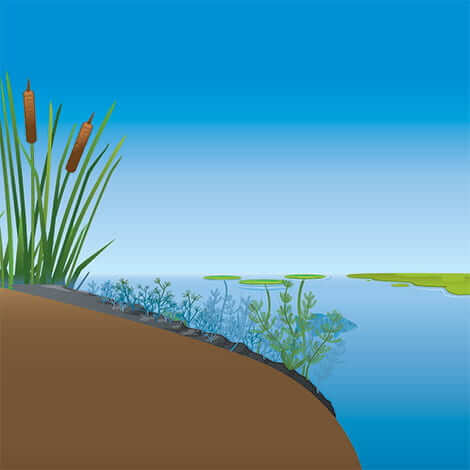You cannot treat what you do not know! Identifying pond weeds is the first step to successful eradication and prevention. Read on for aquatic weed ID tips.
Aquatic Weed Control
As your pond matures, you’ll encounter more weeds and algae blooms. These nuisances can choke the life out of your ecosystem if action is not taken. To best treat problematic weeds, you must identify which types are growing in your pond.
Most chemical treatments address a variety of weeds and algae, such as KnockDown Defense 2-in-1 algaecide and herbicide. Identifying the exact weed species is not always necessary, just the class of weeds it belongs to.
Pond Weed ID Classification
- Algae: Algae are simple plants that lack flowers, leaves, and root systems. Microscopic algae or pond scum often float on the pond’s surface in clusters and turn the water green or brown. Macroscopic algae like Chara look like submerged weeds but are easy to rake out and have a musky odor and a crunchy texture when handled.
- Submerged: Submerged plants feature limp stems that require water to stay upright. They have robust root systems that are difficult to pull free without breaking their soft stalks. Most of the plant remains underwater, but some foliage may grow to the surface and spread out.
- Floating: Generally found in shallower water, floating plants can spread and completely cover the surface, cutting off light and oxygen to the fish below. They are divided into two groups: free-floating and rooted. Free-floating weed roots don’t reach the bottom but hang underneath the plants to absorb nutrients from the pond's water. Rooted-floating plants have long, ropy stems stretching from embedded roots to canopies of foliage that rest upon the water’s surface.
- Emergent: Also known as bog or marginal plants, these weeds grow along the shoreline on land and in shallow water. Emergent plants like cattails have woody, stiff stalks and runner roots that spread out to form stands or reed beds.
Sample and Identify Pond Weeds by Photo
Remove a weed sample for a closer look and note the plant's color, texture, and odor. Try to get a complete specimen with the stem, roots, and leaves, and snap a few pictures. Visit our Weed Identification Guide and click on the image that resembles your plant for a detailed description, photos, and treatment recommendations.
Ask an Aquatic Weed ID Expert
If you are still unsure, email us at weedid@thepondguy.com with your attached photos, and we will help you identify the culprit and recommend the best treatment. Here are some tips to get a quality weed ID picture:
- Take one photo by placing your weed sample in a bucket of water to see the natural stem and leaf structure.
- Take one photo of the sample spread out in your hand or on a blank sheet of paper.
- Include your state (not all chemicals are approved in every state), how the pond is used (e.g., recreation, irrigation, livestock), whether the pond has an outflow, and the approximate size of the treatment area.
For additional weed control advice, call us at 866-POND-HELP today! Read more tips for treating and preventing aquatic weeds in the following related articles:
How to Treat Pond Weeds
How to Reclaim Your Lakefront Shoreline
Invasive Pond Weeds
Aquatic Weed Control and Treatment
Do Pond Weeds Die in the Winter?
Last Updated: May 28, 2024
